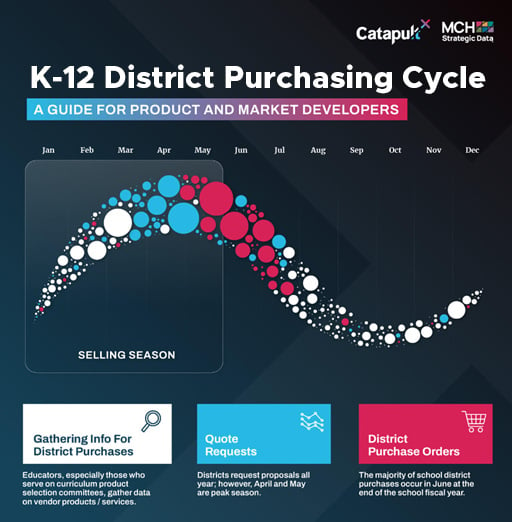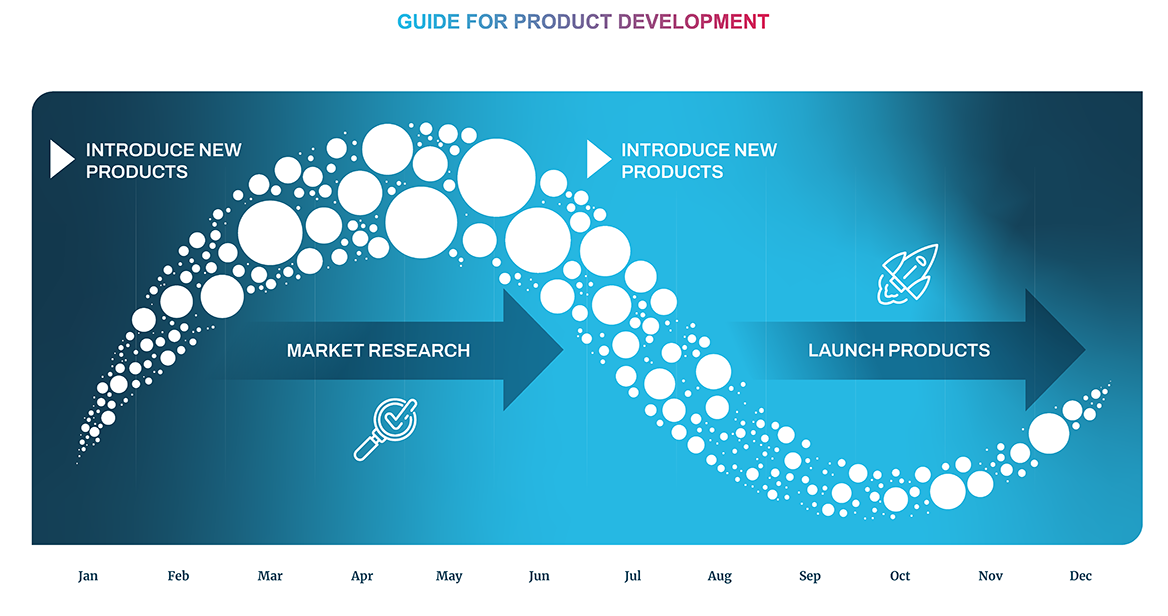September 16, 2024 | Peter Long
Selling to Schools and Districts: An In-Depth Miniseries
The How, When, What and Why of K-12 Purchasing Cycles
For those selling to schools and districts, timing is everything when it comes to seasonal purchasing cycles. While other industries follow distinct annual phases, the K-12 school buying cycle is unique and spending levels differ depending on the time of year. To ensure marketing success, it's crucial to align your efforts with the K-12 district purchasing journey. By staying agile and adjusting your strategies to this cycle, you’ll position your brand for optimal results.
 |
| The chart provided illustrates district transactions, where each bubble represents a sales opportunity, and the size of the bubble indicates the potential order value. It’s essential to remember that information gathering occurs year-round, and smaller purchases do happen throughout the year. |
In this three-part blog series, we hope to explore key insights for both new and experienced marketers selling to schools and districts on the changing landscape of K-12 school purchasing cycle. The past 10 to 15 years have brought significant changes to educational marketing and product sales. New marketing channels have enabled faster communication with educators and administrators, while the "Amazon effect" has accelerated delivery expectations from weeks to mere days. Additionally, the rise of subscription-based apps and device-neutral, cloud-based solutions has transformed the technology access landscape, replacing many traditional paper-based models, even in the most remote schools.
These shifts have created a more dynamic marketplace for educational products and services. The low cost of entry for subscription-based systems, faster communication channels, and the diversity of marketing platforms have transformed the education sector into a more fluid, year-round marketing environment. This flexibility allows companies to reach schools and districts more consistently and effectively than ever before. Yet school budgeting processes and purchasing rules and regulations loom large over the process caging it into more traditional timing that has driven the process for many decades.
"In the education market it is critical to understand what happens when. Because budget cycles in K–12 drive everything it's important to know who's listening when and how many stakeholders need to be involved."
— Daylene Long CEO Founder of Catapult X LLC
What has developed is an interesting hybrid of modern marketing and sales opportunities that utilize modern communication, social media connected educator engagement technology, immediate feedback loops and modern branding opportunities all integrated into the traditional budget driven cycles that have existed for decades. We will discuss modern marketing and connectivity opportunities in more detail in Parts 2 and 3. But before diving deeper into buying cycles, it is important to understand how the sales cycle differs between general K-12 education and STEM-specific programs.
There’s no one-size-fits-all approach when it comes to marketing in the education sector, especially when comparing general education to STEM. While timing is critical, understanding your audience is just as important. In STEM, science educators are not only strong influencers but often serve as final decision-makers for STEM-specific supplies. This distinction plays a key role in shaping effective marketing strategies.
You might wonder, "What’s the difference between general influencers and STEM decision-makers?" Generally, teachers are well-versed in the standards and curriculum they need to follow. They understand which students require special accommodations and know what resources the school offers to meet those needs. Teachers are also aware of the technology available - and - what they wish they had access to. Since they interact with students daily and hold parent-teacher conferences, teachers also gain insight into the social and emotional factors that contribute to effective learning. All of this makes teachers powerful influencers, in the buying cycle, even though they may not have the authority to sign off on purchases. Marketers should recognize and tap into this influence.
STEM educators, however, not only wield influence but often have decision-making authority, thanks to funds specifically allocated for STEM supplies at the building level. While some may work with modest budgets starting at $200 per year, others manage budgets exceeding $10,000 for lab materials, cutting-edge technology, and other up-to-date resources. As subject matter specialists, STEM educators are frequently involved in advisory councils and benefit from recurring yearly budgets, unlike general educators. Therefore, when navigating the district purchasing cycle, it is crucial to understand your audience and ensure STEM educators are part of your primary influencer personas.
At this point, you may be asking, "How can a marketer tap into this opportunity?" The answer is—with caution! In the past, building brand recognition for new products and education-focused companies was a significant challenge. Just 10 to 15 years ago, catalogs, trade show sponsorships, educational magazine ads, and direct mail were the main methods used to slowly promote and grow a company’s educational brand recognition. While these channels remain effective, especially for established brands, they are costly and require years of aggressive investment to gain traction in schools and districts.
Today’s modern marketing tools—such as email, programmatic digital advertising, bloggers, educational influencers, professional development channels, YouTube, and SEO—are not only more cost-effective but also offer greater reach and faster turnaround times. This makes building a new educational brand recognition more attainable than ever. However, for this approach to succeed, marketers must involve educators in the process. Relying solely on district-level decision-makers is a missed opportunity in today’s increasingly dynamic marketplace for educational products and solutions.
Strong new competitors can now swiftly emerge and replace outdated educational products or software solutions. In today’s fast-paced market, the saying "You snooze, you lose" has never been more accurate. Equally important is that marketers remain laser-focused on the educators most relevant to their brand or solution. Targeted messaging and relevance are not just beneficial—they are essential. Over-saturating educators who fall outside your core audience persona will likely result in negative pushback. Striking the right balance between targeting and relevance is delicate but crucial to long-term success.
A football coach is not interested in soccer equipment promotions any more than a math teacher is concerned with history curriculum promotions. By targeting the right audience with precision, you’ll be rewarded with higher engagement, loyalty, shared success stories, referrals, and more.
"Every district has goals as unique as the population they serve. We can't just take a one–size–fits–all approach. My strategy with clients is to partner with MCH to target the right titles for the right marketing strategy."
— Daylene Long CEO Founder of Catapult X LLC
 |
| The educational sales cycle can be visualized as a reverse S-curve, divided into two main phases: product development/awareness and market research. While both can be conducted year-round, aligning these efforts with the buying cycle of educators maximizes brand awareness and drives sales. |
When it comes to gathering feedback from educators and influencers during the product awareness phase, the best time to conduct focus groups and STEM panels is between February and June. Waiting until July or the fall means competing with summer break and preparations for the new school year, making it harder to capture educators' attention.
The back-to-school season is extremely busy for educators, which is why most of your market research and product awareness efforts should occur between January and May. This period is crucial for sales and marketing, as educators are making key decisions about year-end funds and new budgets for July. To maximize brand awareness during the buying cycle, it’s vital to engage educators consistently through emails, webinars, e-newsletters, workshops, and other digital marketing strategies.
In the past, brand building was rarely a topic of discussion. The success of new educational products was achieved slowly and methodically over years of careful effort, often one order at a time, to build scale and cultivate an educator-driven support base. However, today’s product and service companies are leveraging more frequent and targeted touchpoints to accelerate brand awareness. Video influencers, professional development channels, email campaigns, blogs, programmatic digital advertising, and other modern tools have opened year-round opportunities for companies to build their brand while still making crucial sales and marketing pushes during key budget cycles.
Stay tuned for part two of our three-part blog series coming next week!
More Insight from MCH
- Check out in our Back to School Marketing Mini-Series.
- Download our School Calendar Reference Guide for the 2024/2025 school year and get key insights from over 80,000 school calendars across the U.S.
- Download our Email Marketing to Educators 2024 whitepaper.
About MCH
For nearly a century, MCH has empowered educational marketers with the data, tools, and solutions needed to thrive. Our cutting-edge technology continuously updates and verifies millions of educator records, ensuring you have the most accurate information for your campaigns.
Use our free ListBuilder tool to explore our education data, or Contact Us to strategize as a team.
Need More Time?
Due to inactivity, you will be logged out within 5 minutes.
To stay logged in, please select Stay Logged In.





 Logout
Logout